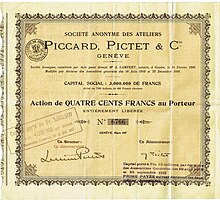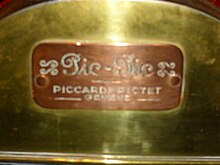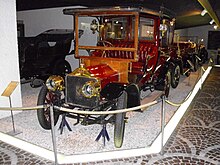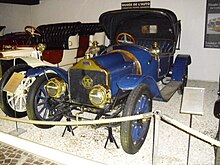Pic-pic
Pic-Pic , short for Piccard-Pictet after Paul Piccard and Lucien Pictet , was a Swiss automobile brand from the manufacturer Ateliers Piccard-Pictet & Cie.
Manufacturer
After the death of Jules Faesch in 1895, Lucien Pictet becomes a partner in Faesch & Piccard in Geneva , in which Paul Piccard is already involved. The company is converted into a general partnership that operates under the name Piccard & Pictet . In 1898 it became the limited partnership Piccard, Pictet & Cie. That in 1906 the corporation Ateliers Piccard-Pictet & Cie. was converted. In the same year, the company began producing automobiles on behalf of the Société des Automobiles à Genève (SAG) .
SAG was a company founded by Lucien Pictet to build and market cars. At that time, only the chassis with the engine were sold - the body had to be contributed by the customer himself. The vehicles built were a design by Marc Birkigt that was manufactured under license. The Swiss Marc Birkigt was the later head of construction at Hispano-Suiza . The SAG cars were identical to the first Hispano-Suiza vehicles except for the radiator . In 1910 the SAG became insolvent and the bankruptcy estate was taken over by Ateliers Piccard-Pictet & Cie. accepted.
The production of cars was started under the brand name Pic-Pic by Ateliers Piccard-Pictet & Cie. continued, whereby up to the First World War around 1500 vehicles were produced in a factory-like production. The vehicles had a good reputation for technical perfection, reliability and quality. During the war, garnet detonators were mainly made for the Entente cordiale . The capital gained was invested in a massive expansion of the factory, which should enable industrial production.
Production of the first series of 500 cars began in March 1919. The valve motor installed in the car was unsuitable for the series production at the time, because very small dimensional tolerances had to be adhered to in order for the motor to function properly. Due to the problems that arose in production, the delivery times could not be met and the cars became unreliable, so that customers jumped out and the Ateliers Piccard-Pictet & Cie. 1920 became insolvent. Until then, another 1500 pic-pic had been created.
The banks took over the bankruptcy estate and founded the Ateliers des Charmilles SA from it in 1921 . This continued to run the brand in collaboration with Gnôme & Rhône until 1924 before production was completely discontinued.
vehicles
In 1910 the 14/18 CV and 18/22 CV models came onto the market. The 40 CV model followed in 1911 . In 1912 a 12 CV racing car was produced. 1914 there was a 20/30 CV as well as a racing car, whose four-cylinder - valve engine of 4500 cc engine capacity 150 hp made. In 1918 the 15 CV model appeared with a four-cylinder valve motor and 2900 cm³ displacement, but this caused problems in production. In 1922 a prototype with a valve motor and a displacement of 3000 cm³ was presented.
Two vehicles of this brand can be seen in the Musée de l'automobile de la Fondation Pierre Gianadda in Martigny and one in the Swiss Museum of Transport in Lucerne .
literature
- Harald H. Linz, Halwart Schrader : The great automobile encyclopedia . BLV, Munich 1986, ISBN 3-405-12974-5
- George Nick Georgano : Cars. Encyclopédie complète. 1885 à nos jours . Courtille, 1975 (French)
- Ernest Schmid: Swiss cars. Swiss automobile designs from 1868 to the present day . Auto-Jahr, Lausanne 1978, ISBN 2-88001-058-6
- Alexis Couturier: Pic-Pic mon amour , Geneva 1994
- Alexis Couturier: R2 le retour , Geneva 2006
- Laurent Christeller: Pic-Pic. Une aventure industrial genevoise . Fondation des archives de la famille Pictet, Geneva 2014
Web links
- GTÜ Society for Technical Monitoring mbH (accessed on December 22, 2013)
- Jean de Senarclens: Piccard-Pictet & Cie .. In: Historisches Lexikon der Schweiz .
- Pictet Family Archives (in French)
- Pic-Pic at mini.43.free.fr (in French) (accessed October 5, 2013)
References and comments
- ↑ a b c d e Bénédict Frommel: L'usine Tavaro. Etat de Genève - L'Office du Patrimoine et des sites, September 2002 (French).
- ^ André Pfenninger: Pic-Pic - a Geneva car icon . In: Journal21 . March 11, 2014 ( journal21.ch [accessed October 3, 2018]).
- ↑ Thomas Gull: Five Things We Should Know About World War I. University of Zurich, September 2, 2014 .





